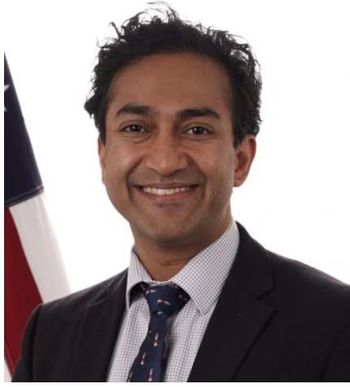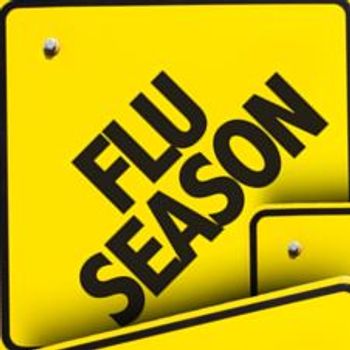
Epiglottitis in a 48-Year-Old Man
A 48-year-old man was admitted with a sore throat, subjective fever, and cough of 2 days’ duration. Two days before admission, he had dysphagia, began to drool, and felt like he was choking.
A 48-year-old man was admitted with a sore throat, subjective fever, and cough of 2 days’ duration. Two days before admission, he had dysphagia, began to drool, and felt like he was choking.
An x-ray film of the neck showed soft tissue swelling at the level of the epiglottis and a thumbprint sign (arrow), which confirmed the diagnosis of epiglottitis. The patient was treated empirically with ceftriaxone and cefazolin. After 3 days, the patient’s symptoms abated, and recovery was uneventful.
Epiglottitis (also known as supraglottitis) has been rare since 1991, when the Haemophilus influenzae type B (Hib) vaccine was first recommended for children. Pathogens that most commonly give rise to epiglottitis are thought to include Haemophilus types A and F (and nontypeable strains); Haemophilus parainfluenzae; Streptococcus pneumoniae; Staphylococcus aureus; and group A streptococci.1
The peak incidence of epiglottitis is during the third year of life; three-quarters of cases arise in children between 1 and 5 years old.2,3 The incidence of epiglottitis in adults is on the rise. Before the Hib vaccine, 0.22 to 1 per 100,000 adults were affected.4,5 There have been reports of the rate increasing to 0.88 per 100,000 between 1991 and 1995 to 3.1 per 100,000 between 1996 and 2000.6 Epiglottitis in adults has been associated with comorbid conditions, such as hypertension and diabetes mellitus.5,7,8
Epiglottitis is marked by abrupt onset of a constellation of symptoms, including fever, severe sore throat, dysphagia, and drooling. Physical symptoms combined with leukocytosis (white blood cell count of 20,000/μL or more and an increased percentage of neutrophils and band forms) are highly suggestive of epiglottitis.9,10 Radiographic visualization of the epiglottis usually confirms the diagnosis. Cultures of blood or epiglottis tissue identify the pathogen responsible for infection. A retrospective study found that the thumb sign was present in 77.5% of radiographs of patients with epiglottitis. In comparison, the vallecula sign was present in radiographs of 1.4% of those with epiglottitis.11
References:
REFERENCES:
1.
Cherry JD. Epiglottitis (supraglottitis). In: Feigin RD, Cherry JD, Demmler-Harrison GJ, Kaplan SL, eds.
Textbook of Pediatric Infectious Diseases.
6th ed. Philadelphia: Saunders; 2009:244.
2.
Faden HS. Treatment of
Haemophilus influenzae
type B epiglottitis.
Pediatrics.
1979;63:402-407.
3.
Cohen SR, Chai J. Epiglottitis. Twenty-year study with tracheotomy.
Ann Otol Rhinol Laryngol.
1978;87(4 pt 1):461-467.
4.
Takala A, Eskola J, van Alphen L. Spectrum of invasive
Haemophilus influenzae
type disease in adults.
Arch Intern Med.
1990;150:2573-2576.
5.
MayoSmith MF, Hirsch PJ, Wodzinski SF, Schiffman FJ. Acute epiglottitis in adults. An eight-year experience in the state of Rhode Island.
N Engl J Med.
1986;314:1133-1139.
6.
Berger G, Landau T, Berger S, et al. The rising incidence of adult acute epiglottitis and epiglottic abscess.
Am J Otolaryngol.
2003;24:374-383.
7.
Chang YL, Lo SH, Wang PC, Shu YH. Adult acute epiglottitis: experiences in a Taiwanese setting.
Otolaryngol Head Neck Surg.
2005;132:689-693.
8.
Wolf M, Strauss B, Kronenberg J, Leventon G. Conservative management of adult epiglottitis.
Laryngoscope.
1990;100:183-185.
9.
de Diego JI, Prim MP, Hardisson D, et al. Graft-vs-host disease as a cause of enlargement of the epiglottis in an immunocompromised child.
Arch Otolaryngol Head Neck Surg.
2001;127:439-441.
10.
Johnson GK, Sullivan JL, Bishop LA. Acute epiglottitis: review of 55 cases and suggested protocol.
Arch Otolaryngol.
1974;100:333-337.
11.
Ng HL, Sin LM, Li MF, et al. Acute epiglottitis in adults: a retrospective review of 106 patients in Hong Kong.
Emerg Med J.
2008;25:253-255.
Newsletter
Enhance your clinical practice with the Patient Care newsletter, offering the latest evidence-based guidelines, diagnostic insights, and treatment strategies for primary care physicians.
























































































































































































































































































